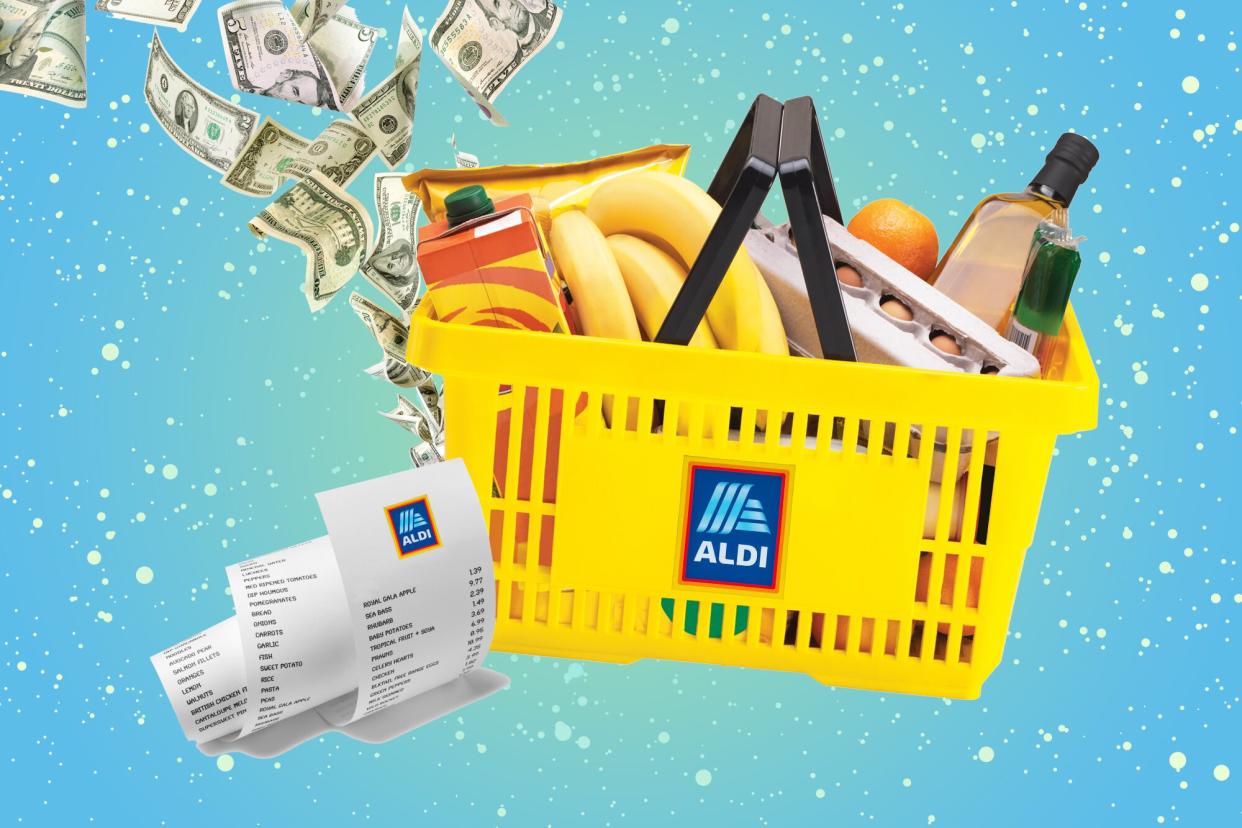I Saved $70 a Month Just By Grocery Shopping at Aldi—Here's How They Keep Prices So Low

Getty Images; EatingWell collage
This year, like many others, I noticed I was spending so much more money on groceries than ever before. Between inflation and my college student budget, I had a lot of anxiety when I would look at my monthly grocery bill.
Then, Aldi came into my life. Friends and colleagues told me that Aldi was much more affordable compared to other national grocery chains. The national chain has over 2,000 stores across the country and prides itself on its priority focus, which is "saving people money on the food and products they want the most," according to their website. I was initially doubtful about these claims, but after two grocery trips to Aldi, I was hooked.
After making Aldi my go-to grocery store, I did a little math project. The result? Since shopping exclusively at Aldi, I've saved $70 per month. When comparing my grocery bills from my pre-Aldi days to now, I was obviously mind-blown.
So, how exactly does Aldi keep its prices so low, and can it really compare to other grocery chains? We have the answers.
Related: 5 "Polite" Things You Do at Aldi That Are Actually Rude
How Aldi Keeps Grocery Prices Down
Aldi has you return your own shopping cart
If you've ever shopped at an Aldi location, chances are you've noticed how unique a grocery shopping experience it was. These unexpected quirks aren't just for fun, though, they're actually important business strategies Aldi uses to keep costs down for their customers.
If you're an Aldi newbie like me, take note of the shopping cart etiquette. Aldi chains their shopping carts together and leaves them outside the store. When you go to pull a cart out, you have to insert a quarter into a slot, which unlocks the cart from the others in the corral. When you're finished with your cart, you simply lock it into the other corralled carts. This releases the quarter out of the slot for you to take!
This shopping cart system is a money-saving practice for Aldi. By eliminating the need for employees to keep track of shopping carts coming in and out of the store, they save some costs that ultimately result in lower prices for customers.
Aldi puts the customer to work
One thing that may seem a bit overwhelming when first shopping at Aldi is how the cashier doesn't help bag groceries. As the cashier scans items, they'll instead place them back in the cart and leave it for the customer to handle themselves. The bag counter area is for you to bag your own groceries into the reusable bags you brought (a very important part of Aldi culture).
By having customers do a bit more work, Aldi eliminates the need for grocery baggers. Without having to pay for extra labor, Aldi's product prices are lower than its competitors who have more employees to pay. While bagging your own groceries at Aldi can seem intimidating at first, fear not. Watching the customers in line ahead of you can usually clue you in to the intricate system.
Aldi sticks to their products
One thing particularly notable about Aldi is how 90% of their products are private label. They do carry some name-brand products, but the majority of products are produced by the chain's own producers. This brings costs for customers down because Aldi is controlling their own product prices, rather than having to align with commercial prices. Essentially, they are controlling their own market! Related: 20 Items at Aldi under $10 You'll Want to Buy Forever
Aldi makes stocking shelves a science
As a first-time Aldi shopper, I noticed that the grocery store is much different visually from the other chains I was used to. Their shelves aren't the shiny, pristine displays of food products that so many stores go out of their way to set up. Instead, Aldi's products are kept in the display-friendly boxes that they were shipped to the store in.
This deliberate decision makes it easier for employees to stock shelves, as they can eliminate the fuss of making shelves look like art projects. The large shipping boxes that get sent to the store have removable sides, so when they go up on shelves, customers can easily reach in and grab the individual items. Produce also comes pre-packaged for easy access. By eliminating the need for intricate product displays on shelves, Aldi does not have to hire additional employees to spend their time on shelving products.
How Do Aldi's Prices Compare to Competitors'?
To paint a picture of how much cheaper Aldi's products are, I did a quick price comparison of Aldi essentials to those from other grocery competitors. For example, a loaf of whole-wheat bread at Aldi is $1.99, while a whole-wheat loaf at Safeway is $4.49. A gallon of 1% milk at Aldi is $3.05, while it will cost $3.29 at Albertsons. Finally, eggs at Aldi are $2.59, while the same carton of grade A large eggs will cost $5.99 at Target.
While these price differences may seem like only a few cents, those saved cents can turn into a pretty big sum on a monthly basis.
Do Aldi's Low Costs Mean Low Quality?
In my experience, Aldi products are comparable to name-brand products that other grocery stores offer. From produce to canned goods, all my groceries are delicious and high-quality. To keep its promise of product integrity, Aldi has a "Twice as Nice '' guarantee where customers can bring back Aldi-exclusive products they are unsatisfied with to get a full refund and replacement.
Bottom Line
If you're looking to save money on your next grocery trip, consider shopping at Aldi. The store's cost-saving measures, like having customers bag their own groceries and selling Aldi-branded products, help ensure their prices are affordable, especially when compared to other chains.

